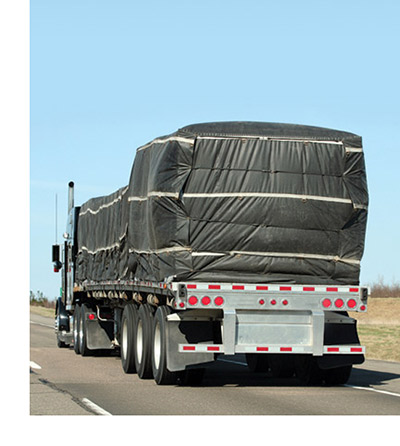Flatbed truck drivers have a dangerous job. Not only do they drive on America’s highways everyday regardless of weather conditions, some of their other job duties are just as dangerous. Believe it or not, something that sounds pretty simple – like covering a load with a tarp – can lead to injury and sometimes even death.
 Why Tarp?
Why Tarp?
Flatbed trailers are highly versatile and that makes them a cost effective and very popular mode of shipping. Flatbeds can accommodate different types of loads whether they are heavy, oversized, or unusually shaped. Depending on the type of product, it may need to have a tarp over it, especially if inclement weather can damage the product. Also, certain items may come loose and blow off the truck onto the road causing a hazard to other drivers. Tarps also protect loads that could be damaged by road gravel and other flying bits. Sixty-percent of all flatbed shipments require tarping and that greatly increases the number of instances when falls can occur.
Where the Danger Lies
Manual tarping is the most common way to cover a load, but it is also the most dangerous. First an operator must climb on top of the flatbed. Often this climbing is done without the benefit of a properly designed ladder or platform. There are usually no guardrails either. Tarps are heavy. They can weigh anywhere from 80 to 150 pounds, so spreading one is not for the weak. Also, when it rains a plastic tarp can become extremely slippery.
When a driver manually spreads a tarp, he/she is walking across the load to do so. This is dangerous because there may be uneven surfaces, holes, heavy winds, and loose product. Any of these can create perfect instances for a fall. The fall is a big deal even though it may look like the flatbed is not too high off the ground. It is high enough to cause injury and even death. The driver could land on a shoulder spraining it, or garner injuries to the head, neck, and back. All of these injuries add up to thousands of dollars in workman’s comp plus days, weeks, or months of time lost.
Know Your Company’s Obligations
Due to the versatility of flatbed trailers, it is not likely they will be replaced in the near future. There are few U.S. standards and regulations that actually address tarping. So a lack of rules and enforcement create little incentive to correct the fall risks associated with tarping. This means the obligation is on each individual company. Every time a truck drives onto your business property, you are held accountable for the safety of the individuals loading your products onto their flatbeds. Don’t wait until there is a fatality to make changes.
Fall Protection Platforms
Sam Carbis Solutions Group, LLC works to make job sites safer by manufacturing equipment for trucks and rail cars. When it comes to tarping flatbeds, we manufacture two types of fall protection. The first is a pair of platforms that allow drivers to work above the danger by placing them higher than the load. These aluminum platforms keep drivers out of harm’s way with non-skid surfaces and side guardrails. Drivers can safely and easily tarp their flatbeds, inspect loads, and anything else that may be needed. Once the flatbed is positioned between two platforms, an operator uses the remote to sandwich the trailer between the two platforms by adjusting them horizontally. At that point a driver can safely reach the load for inspecting, tarping, or sampling.
Sam Carbis Solutions Group, LLC can customize these platforms to meet your company’s unique needs with:
• Fixed position or rolling designs
• Single or double-sided systems
• Optional canopy for inclement weather protection
• Optional swing gates for an extra level of fall protection
Overhead System
The ideal safety solution for “a perfect world scenario” is tarping a flatbed using an overhead tarping system. This way the driver’s feet remain on the ground at all times making falls from heights obsolete. The overhead system uses an electric motor to pull the tarp over the length of the flatbed. The operator simply connects the tarp to the spreader bar then guides it along the length of trailer with the hand-held control. This overhead system saves lives, manpower, time and money. It also reduces ergonomic injuries and eliminates falls from the flatbed. An overhead tarping system can be added to an existing structure or designed as a freestanding unit. It is easy to use and requires only one operator.
It is up to each company to ensure their workers are safe on the job. Let Sam Carbis Solutions Group, LLC help you ensure worker safety with tarping platforms and systems that also improve throughput and save you money in the long run.



